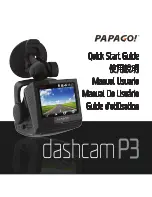
To release the shutter, press the release button with the ball of the index finger. Use finger pressure only, and keep the band and its
grip on the camera steady. The actual pressure should be slow and smooth, The slower the exposure time, the smoother must be the
release.
For slow exposures in the hand, it is advisable to rest the elbows or at least to lean the body against some support in order to avoid
shaking. In this way, 1/15, 1/8 and even¼ see, can be risked without incurring camera shake.
Such a support is also desirable for faster exposures, as various movements take place inside the camera after pressing the release
button. A slightly unsteady hold may thus easily lead to blurred pictures
The use of a tripod or other solid support is necessary when taking time exposures and it is also recommended for speeds from 1/15
to 1 sec. It is useful even for normal instantaneous shots (1/30 to 1/125 sec.) where circumstances permit.
Carrying
To he ready for quick action, it is best to carry the camera on its shoulder strap round the neck so that it lies on your chest, lens
downwards. Lifting it up then takes a split second.
For convenience and protection, carry the Hasselblad in its ever-ready case. It is then only necessary to open the flap to get the
camera ready for use.
The camera neck strap itself goes through the ever-ready case.
Viewing and Focusing
You can view and focus only after the shutter has been wound. This operation brings down the mirror into its viewing position to
reflect the image from the lens on to the ground glass screen. So you know that when the image is visible, the film is also advanced
for the next shot (the film transport is coupled with the shutter tensioning mechanism).
The image appeals in natural size, free from parallax.. A Fresnel-type field lens ensures even illumination right into the corners of the
screen.
The lens is used at full aperture for focusing. This shows up the difference between a perfectly sharp and slightly unsharp image to the
greatest degree; at a smaller lens stop it is not so easy to adjust the lens exactly to its sharpest setting. Such critical focusing also
leads to emphasis of the main subject by good definition - thereby separating it from its background. This is the first decisive step
from the casual snapshot to a real picture. The focusing screen is the most efficient means of photographic collation. Unlike any other
viewfinder it presents a two-dimensional, full-size preview of the photograph as it will look later. The man who cannot be taught to
"see" photographically by the ground glass of a camera will never learn to do so.
To open the hood, push its catch to the right. The hooding of the finder keeps stray light from the screen, and so makes the images
appear brighter. To close the hood first fold down both sides, followed by the back and finally the front.
Although you are likely to hold the camera reasonably level, make sure that vertical and horizontal lines of the picture run parallel to
the cross engraved on the screen. You can tilt the camera intentionally, but see that the effect does not look like an accidental tilt.
The picture on the screen appears upright, but reversed left to right. Movements are also reversed left to right; to follow moving
subjects you therefore have to turn the camera against the apparent subject movement.
Waist-level and Eye-level Viewing
With the camera held at chest or waist level for reflex viewing you see many popular subjects - children, animals, people sitting down-
from a more natural viewpoint than when looking down from eye-level. More natural, that is, for the subject, for the camera gets
down automatically to the subject level. Informal portraits, candid studies, can be got quietly and without fuss.
For unobserved shots hold the camera at right-angles, with the lens pointing to the left or light instead of straight ahead. To take
pictures over the heads of a crowd or to obtain a higher viewpoint, hold the camera above your head, viewing up into the reflex
screen.
The camera is used at eye-level with the pentaprism and the prism sports viewfinders, where the image appears upright and the right
way round. These are therefore the finder units to choose when the cameras should be used at eye-level for viewing and focusing,
particularly when following moving objects with the camera.
The sports frame finder serves the same purpose as the pentaprism and prism sports finder, but does not permit reflex focusing at the
same time. This is therefore primarily intended for sports, landscape, or other distant subjects, or for shots where you pre-focus on a
subject that remains at the same distance from the camera.
A separate frame viewfinder to, Sonnar 150 and 250 lenses snaps on the lens hood
Focusing Technique
www.mr-alvandi.com
Содержание 1000 F
Страница 18: ...WILD LIFE www mr alvandi com ...
Страница 52: ...THE CUT FILM ADAPTOR www mr alvandi com ...
Страница 54: ...Daylight Exposure Values www mr alvandi com ...
Страница 55: ...Filters for Black and White Film www mr alvandi com ...
Страница 57: ...Colour Temperatures and Light Sources Light Balancing Filter Data Filter Equivalents www mr alvandi com ...
Страница 59: ...Close Ranges with 50 60 mm Distagon and Planar 80 mm www mr alvandi com ...
Страница 60: ...Close Ranges with 120mm S PLANAR 150 200 mm SONNAR www mr alvandi com ...
Страница 61: ...Focusing Ranges with the Extension Bellows Shutter Speeds to Arrest Movement www mr alvandi com ...
Страница 62: ...Conversion of Film Speed Systems Colour Films www mr alvandi com ...
Страница 63: ...Black and White Films www mr alvandi com ...
Страница 64: ...www mr alvandi com ...



































